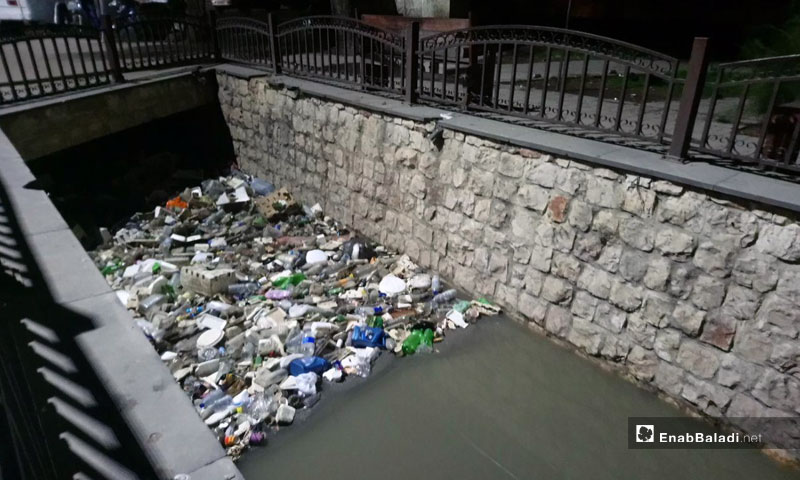The river of Barada, which constitutes a part of Damascus’ fame and the symbol to which poets devoted several of their writings throughout history, is today forgotten, forsaken for litter and sewage products to fill, turning it into a dirty trickle disposing diseases while running through the Damascene neighborhoods.
The river’s seven famous distributaries, water channels that could be seen everywhere in the city, dried away due to governmental neglect and security considerations which blocked many of them, in addition to litter that is filling the river in Damascus and its principal neighborhoods.
The Barada river springs from the southern parts of the al-Zabadani region, north-western Damascus, from where it starts the journey through the Wadi Barada/the Valley of Barada. At one point, the al-Fijeh spring supplements it with the abundance of its water and from there it continues to the areas of al-Hamah and Dumar until it reaches the area of al-Rabweh, the gate to Damascus.
In the area of al-Rabweh, the river splits into seven distributaries, running through the city; and then, it takes a detour to eastern Ghouta, offering it irrigation water, where finally it empties into the Otaybah lake.
The river, for years, has been highly celebrated starting with the Aramaic era reaching the Islamic one, especially under the Umayyad Caliphate, for its tributaries are considered as one of the most ancient irrigation networks in the world.
The River is a Swamp of Waste Products
Early in February, videos went viral on social networking sites, showing the river filled with litter. Enab Baladi interviewed several of the city’s residents concerning the current state of the river.
The majority of the opinions hold the government accountable for what they described as a “disaster.”
Khalid, a twenty-year-old young man, said: “Damascus has exchanged the fragrance of Jasmine with that of the river. The state must come up with a solution, especially prior to summer, keeping in mind the damage and the diseases that might be caused by the river’s current status and the litter.”
“My house overlooks the river; the smell it defuses, and the insects are making my children ill,” according to Um Samer, a resident of the al-Rabweh area, who filed several complaints to the Municipality Council, which keeps answering her that the matter is being studied.
A few years ago, the river was Damascus people’s breathing space, most of whom used to resort to its banks in Ain al-Fijeh, al-Rabweh and al-Ghouta; however, this breathing space is today a burden to Damascus’ population and the area’s where the river runs, after it became a dumpster to the restaurants’ waste and a part of the sewage system.
No Solutions to Save Barada
The Syrian government is keeping silent about the river’s current situation, but the Ministry of Environment has conducted a study in 2013, in which it examined samples of the river’s water. Back then, the Ministry concluded that its low level has turned it into a stream field with visible solid litter. Some of the solid waste products float to the surface, with algae growing on them.
The study added: “[The river’s] water is highly polluted and poses a danger to humans and environment; it is also unserviceable.”
Late in 2017, the Ministry of Local Administration and Environment allocated four billion Syrian pounds to rid off the Barada river’s pollution from its spring to the place where it empties its water, including cleansing the river, under a project it referred to as “the strategic project to address root causes,” as to develop the environmental and water reality in Damascus and its countryside, al-Thawra newspaper reported.
Back then, the Damascus Provincial Department said that a water treatment plants are to be built in the area of Jamraya, with a cost of 6.5 billion Syrian pounds, and at the cement factory in the city of Dumar, for a cost of four billion Syrian pounds, in addition to allocating 1.5 billion as to implement a sewage network from Ain al-Fijeh to the plant, with a length of 7700 meters, to be achieved in two years.
Nonetheless, the river’s current status shows governmental reform that complies with neither the river’s symbolic value nor the economic value it is expected to offer the capital’s population.

